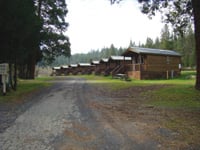 Every year millions of people travel from throughout the United States and the world to visit Yosemite National Park in California. Many arrive in motorhomes—whether their own or a rental—but before you make the trip in a motorhome, there are several important factors to consider.
Every year millions of people travel from throughout the United States and the world to visit Yosemite National Park in California. Many arrive in motorhomes—whether their own or a rental—but before you make the trip in a motorhome, there are several important factors to consider.
If you want to take maximum advantage of the comfort and versatility afforded by a motorhome while experiencing the incomparable splendor of Yosemite, we have some suggestions. They are based upon nearly 43 years of RVing and multiple visits to Yosemite via three of its four gateways, from Highways 120, 140 and 41. (We’ve never used the Tuolumne Meadows access, as it is closed much of each year by snow.)
Yosemite is such an iconic, beautiful destination, so filled with nature’s wonders, that many (including us) want to share it all—time after time—with kids, grandkids and friends. By using RVs, several families can travel from different locations and get together for a weekend or a week to enjoy all of the comforts of home in a magnificent setting.
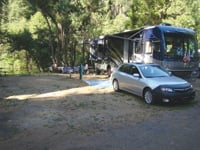 But one of the most important things to keep in mind is that generally the larger the motorhome, the fewer options available on where to stay. If you own or rent a small Class B or Class C motorhome that has sufficient power and braking to negotiate the many uphill and downhill grades, and you have the patience and determination to make your reservation months in advance (via the National Park Service reservation website), then one of the campgrounds within the park may work. We have seen plenty of smaller motorhomes on the way to and from Yosemite and on the valley floor. But unless you have a dinghy, motorcycle, or are used to long treks on a bicycle, there is still the problem of keeping others from taking over your campsite if you plan on using the motorhome for transportation to attractions throughout the valley. Also, parking space is severely limited at many of the best vista points.
But one of the most important things to keep in mind is that generally the larger the motorhome, the fewer options available on where to stay. If you own or rent a small Class B or Class C motorhome that has sufficient power and braking to negotiate the many uphill and downhill grades, and you have the patience and determination to make your reservation months in advance (via the National Park Service reservation website), then one of the campgrounds within the park may work. We have seen plenty of smaller motorhomes on the way to and from Yosemite and on the valley floor. But unless you have a dinghy, motorcycle, or are used to long treks on a bicycle, there is still the problem of keeping others from taking over your campsite if you plan on using the motorhome for transportation to attractions throughout the valley. Also, parking space is severely limited at many of the best vista points.
A better option is to use the Yosemite Valley Shuttle. It travels a continuous loop throughout the valley pretty much year-round. It makes stops at campgrounds, eateries, shopping areas, major attractions and trailheads. During the summer, buses run every 20 minutes. During winter, it is every 30 minutes. (For more information about shuttle routes and schedules, check the website listed in the sidebar.)
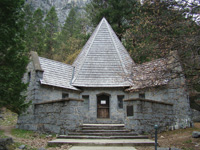 Exploring the valley floor on foot or bicycle is also worthy of consideration. Bicycles can be rented at Curry Village or Yosemite Lodge. During peak season both are open from 10 a.m. to 5:30 p.m. daily. Mostly paved, level trails lead to attractions throughout the valley. The trails afford easy access for anyone on foot or bicycle. They also allow wheelchair access from shuttle stops.
Exploring the valley floor on foot or bicycle is also worthy of consideration. Bicycles can be rented at Curry Village or Yosemite Lodge. During peak season both are open from 10 a.m. to 5:30 p.m. daily. Mostly paved, level trails lead to attractions throughout the valley. The trails afford easy access for anyone on foot or bicycle. They also allow wheelchair access from shuttle stops.
Getting a campsite within the park for even a small motorhome is not an easy task. Campsites fill up daily from April through September, so reservations are a must. Reservations can be made up to five months in advance. Inventory goes on sale the fifteenth of each month. Many of the popular sites, and entire campgrounds, may be filled by the first day they become available—often within a few hours!
Some other considerations to keep in mind: there are no hookups anywhere in Yosemite; there are only a dozen sites in the entire Yosemite Valley that can accommodate larger rigs of up to 40 feet; many of the campsites that can accommodate motorhomes are only open from May through September, and several of the dump stations are only open during peak season.
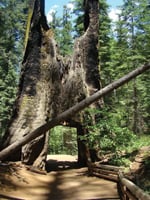 Having said that, we’d like to point out some other options that will afford the luxury and convenience of leaving even a very large motorhome in place, in a very nice RV resort outside of the park, complete with plenty of amenities including full hookups. You can have all of that, and still be able to explore Yosemite—even if you don’t have a dinghy.
Having said that, we’d like to point out some other options that will afford the luxury and convenience of leaving even a very large motorhome in place, in a very nice RV resort outside of the park, complete with plenty of amenities including full hookups. You can have all of that, and still be able to explore Yosemite—even if you don’t have a dinghy.
Choose a nice RV resort close to one of the stops of the Yosemite Area Regional Transport-ation System (YARTS) and you can enjoy the park without staying within its boundaries. YARTS makes stops along the three main highways (41,120 and 140) that lead to Yosemite. Just take a convenient, practical and comparatively inexpensive bus ride to Yosemite and then use the free transportation that is available inside Yosemite Valley. There is a major push to reduce traffic congestion and pollution, so the National Park Service has gone to great lengths in making public transportation convenient and affordable.
Our favorite route to Yosemite is Highway 120, where YARTS makes stops in Jamestown, Sonora, Groveland, Buck Meadows, and at our personal favorite—Yosemite Lakes RV Resort—which is only five miles from the northwest entrance to Yosemite (at the Big Oak Flat gate). Beyond the entry point, it is only about another 25 miles to the valley floor. That is a much shorter and more scenic way to reach the valley floor than alternative routes.
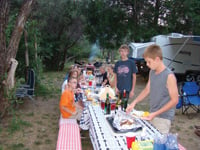 Yosemite Lakes RV Resort is a wonderful place to stay! We’ve been there twice already, and plan to return for more visits. Located on a huge meadow, nestled in a pine forest, with the south fork of the Tuolumne River meandering through the property, this 400- acre resort offers all sorts of amenities. Among those are some not normally encountered, such as trout fishing, kayaking, and putt-putt golf. It is open all year, has full hookups—including right along the river, and can accommodate rigs of any size.
Yosemite Lakes RV Resort is a wonderful place to stay! We’ve been there twice already, and plan to return for more visits. Located on a huge meadow, nestled in a pine forest, with the south fork of the Tuolumne River meandering through the property, this 400- acre resort offers all sorts of amenities. Among those are some not normally encountered, such as trout fishing, kayaking, and putt-putt golf. It is open all year, has full hookups—including right along the river, and can accommodate rigs of any size.
From that wonderful setting, you just walk up to the store and gas station to catch YARTS. The fare includes the gate fee into the park. Those who are handicapped, adults 62 and older, and children under 12 get a reduced price. And with each paid adult, one child rides free. Fares from each stop are listed on the website. Based on our own experiences, fares are probably less than it would cost in fuel alone (not including gate fee), just to drive to and from the free shuttle service. Plus, there isn’t the added stress of driving there, and then looking for parking. Please keep in mind though, that having the exact fare will expedite boarding and reduce frustration by all. It is not a good time to present a travelers’ check or large bill.
We do have a caveat pertaining to use of RV resorts near YARTS stops along Highway 120, above Sonora; and along Highway 140, near and above Mariposa: The highway from Sonora to Groveland, beginning above the fish hatchery at Moccasin Creek, near Don Pedro Reservoir, is very steep and curvy for several miles along new Priests Grade. The old Priests Grade is even worse, and has a weight limit of 7,500 pounds. The highway leading toward Mariposa from the Bagby Recreation Area, is likewise very steep and curvy. So if there is a question about power or brakes, it might be best to use a resort below those two potential problem areas.
Yosemite is such a nice place to visit, and there is so much to see and do that we have returned several times. Since discovering how nice and easy it is to get several RVs together at a place near the park year-round and access the park’s attractions with affordable public transportation, we plan to use that ideal combination at least once a year—to get family and friends together.
Ken Reid is a veteran RVer who lives in Modesto, California.
IF YOU GO:
Yosemite Information: For answers to most questions about Yosemite, visit yosemitepark.com/sitemap.aspx.
Transportation: For general information on getting around Yosemite Valley on public transportation, visit yosemitepark.com/public-transportation.aspx. For schedules and fares for the Yosemite Area Regional Transportation System (YARTS), visit yarts.com.
Camping: To reserve campsites inside the park, visit nps.gov/yose/planyourvisit/camping.htm. There are a number of private RV parks near Yosemite. Websites include rvonthego.com/Yosemite-Lakes-campground-profile.html and yosemitepinesrv.com/Yosemite-lakes.htm.
Visitors Centers: There are visitor centers along each of the highways leading to Yosemite. On Highway 120, the center is at 11875 Ponderosa Lane, Groveland (800-449-9120; YosemiteChamberofCommerce.com). On Highway 140, the center is at 5158 Hwy 140, Mariposa (209-966-2456; homeofyosemite.com). On Highway 41 through the southern gateway, the center is at 40637 Highway 41, Oakhurst (559-683-4636; yosemitethisyear.com).

Leave a Reply